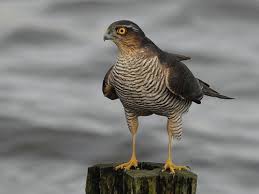 Sparrowhawks (Accipitern nisus) can be 7 to 12 years old (but on average only 2).
Sparrowhawks (Accipitern nisus) can be 7 to 12 years old (but on average only 2).
The male is 29-34 cm, wingspan 58-65 cm, weight: 180 grams. The female is considerably larger: 35-41 cm, wingspan 67-80 cm, weight 280 grams. The upside is bluish gray, bottom off-white with thin rust-colored horizontal stripes. Over the long, narrow tail run some broad, dark cross bands. They have short, rounded wings, a white spot in the neck and long legs.
The sparrowhawk nests in wooded area with lots of cover. He has several lookouts, fixed plucking posts and nests that are used alternately.
He makes a new nest each year, often in an abandoned existing (crows) nest in trees (with under growth) between 5 and 12 meters high. The male feeds the female while she incubates 4 to 6 bluish white, dark brown signed eggs (March-June). The young are stark white.
At high altitudes, he can be confused with the male hawk, closer with cuckoo.
Sparrowhawks are hunted by hawks so you will see breed him rarely in a hawk territory.
He delves cycling, each time with 3 or 4 wing beats, and then floating, to prey and hunts in parks, towns and villages. Sparrow hawks get their prey by surprising them from cover. In places without coverage they cannot. It flies low over the ground, between bushes and sometimes runs small pieces.
Single (little) (song) bird on his menu: house sparrow, chaffinch, blackbird, starling and co.
Sparrowhawk females can get starlings, pied woodpeckers, thrushes and jays and occasionally the size of turkish turtle.
Fowl are safe: they are too heavy and do not fly.
The cuckoo would look similar to the hawk and sometimes use this to disturb birds from their nest.
The cuckoo is a brood parasite that lays with her bulgable fallopian tube in a nest where at least already one egg is in 9 seconds puts hers, and eats or discards another. They use more than 100 species of insectivorous foster parents, as the reed warbler, white wagtail, pipit, Dunnock ... But every cuckoo uses whenever the same type childminders as those in which they grew up themselves, and for which she lays very similar eggs.
The still blind and naked young is working toward the bottom of the nest, and tries to work all the other eggs and baby birds out the nest between the wings on his back.
After plus minus 17 days of great care by the host parents the greedy glutton leaves the nest. It is the only bird that eats hairy caterpillars. The indigestible parts come out as a pellet.
In July / August the adult cuckoos migrate to the south, in September / October the young cuckoos follow.
